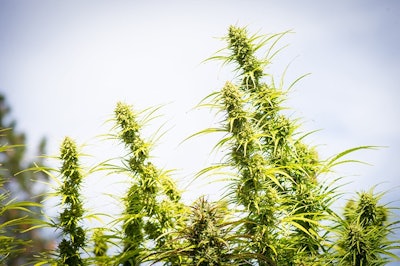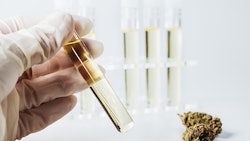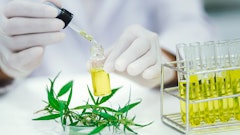
East Fork Cultivars is a small cannabis cultivation company that’s making big strides in sustainability.
The sun-grown operation sprouted up on a former llama ranch on 9 acres in southwest Oregon’s Illinois Valley in 2015, when brothers Nathan and Aaron Howard founded the company to help provide high-CBD medical marijuana to their third brother, who suffers from neurofibromatosis and epilepsy. Since then, the business has grown to just over two acres of cultivation space, all crafted around sustainability.
“Aaron came out of [the] organic vegetable farming world, and he wanted to take the opportunity with cannabis … to talk about sustainable agricultural practices,” East Fork’s CEO, Mason Walker, tells Cannabis Business Times.
Currently in its fourth growing season, the company can grow 40,000 square feet of cannabis under Oregon’s regulations, and it takes full advantage, maintaining just under an acre of mature canopy area. East Fork also grows hemp under the state Department of Agriculture’s rules, which makes up the rest of its cultivation space.
East Fork partners with several infused product companies in Oregon and powers roughly a third of the CBD-infused products on the market, Walker estimates.

A CBD-rich phenotype of Bubba Kush in full bloom.
From the beginning, the company has grown its crops in native soil, which is fairly uncommon in cannabis cultivation, Walker says. “Most folks that grow cannabis, if they grow inside, then they certainly grow in pots or containers, but even outdoor growers often grow in raised beds or containers. We don’t use any containers or raised beds. We grow fully in the native soil of our valley in Southern Oregon.”
Although this method yields less cannabis per acre than growing in containers or amended soil, Walker says it upholds the company’s goal to build the soil health in the area.
East Fork has been experimenting with Korean Natural Farming (KNF), which implements fermented nutrients that introduce microorganisms to the soil to help boost overall soil health. “We’ll be fermenting a lot of things this year, making big pots of stinky stuff that will go out to make healthy soil,” Walker says. “Just like you’d want a healthy gut flora, … we’re doing that same thing on our farm where we’re feeding our soil these fermented items to promote the good bugs.”
The farm also uses drip irrigation with water obtained from the river valley through the property’s water rights. East Fork can draw water from the river at a set time each week, and it has developed an irrigation system designed to minimize water use. Valves are placed throughout the field and can be turned on and off in different areas to water very specific places. The water then drips very slowly through driplines, directly into the soil, to prevent evaporation that might occur with a sprinkler system or hand watering. East Fork uses only about four to five percent of its allowable water right through this system, Walker says.

Wildflowers and fruit trees flank East Fork's North Canopy, an area of the farm designated for growing CBD-dominant varieties of cannabis.
East Fork uses fertigation—adding nutrients to the water to fertilize while irrigating—and the only food given to the plants throughout the year is compost teas, Walker says. To make a compost tea, organic material (or compost) is put in a mesh bag, which is steeped in a large tank of water. The water takes on the rich nutrients from the compost and is then pumped through the irrigation system.
“We can actually add microorganisms in through our fertigation system to aid with the overall soil health, and the healthier the soil is, the less water we need to use and the healthier our plants are, so the less pest management we have to do,” Walker says.
East Fork uses several methods to proactively manage pests without spraying pesticides, he adds. “We actively solicit the help of beneficial insects and microorganisms throughout the year, and by actively inviting those helpers, we have to spray very, very, very little, and the pesticides we do use … are organic-certified pesticides, so they’re allowable on organic agriculture.”
The company harvests indigenous microorganisms like molds and fungi to keep pests under control. Rice is placed in the woods near the farm and microorganisms begin to eat it and break it down. The microorganisms are then fed organic sugar, so they can form a larger colony.
“We use that colony and basically pump that out through our irrigation system, and that colony of bugs will basically prevent against potential pests,” Walker says. “Those molds will actually ward off little mites and aphids and bugs that may pop up with less life in our soil.”
Wildflowers are also planted throughout the entire field, he adds, to act as insectary plants. They provide an ecosystem for a whole range of insects to live alongside the cannabis plants and guard against destructive and unwanted pests. “We’re basically creating this lively ecosystem for good bugs to hang out in,” Walker says.

East Fork grows an abundance of different plants around its cannabis farm to create a habitat for wildlife, particularly beneficial insects.
East Fork is working toward a closed-loop system, he adds, where it doesn’t have to bring in any outside amendments, sprays or fertilizers. “We don’t have to bring any of those on the farm, and that’s a huge economic driver for us because a lot of farms spend a ton of money on bringing in new soil for each growing cycle that they put in pots or bringing in a bunch of sprays,” he says.
A closed-loop system also bolsters sustainability efforts by reducing the farm’s ecological footprint, he adds.
“Cannacultural” Areas
The Illinois Valley is fertile with abundant water, making it an ideal place to grow cannabis, Walker says, and East Fork is currently researching whether terroir, or the ability to taste a region in a product (like wine), is detectable in cannabis. The latitudes and types of sunlight, soil types and regional pests may all work to differentiate cannabis grown in different areas, Walker says.
The company conducted a study with Portland State University last year where the same variety of plants were grown at cannabis farms all over the state and in indoor facilities, and the varieties were then genetically sequenced and chemically analyzed to see if distinct differences exist. East Fork is still waiting on the results of the study but hopes it can shed light on what sort of flavors and compounds develop in different areas, so they can find what they call “cannacultural” areas, which would mimic vinicultural areas in the wine industry.
East Fork has a full cannabis breeding program on-site and has developed many of its own varieties and seed lines, always breeding for chemical diversity, Walker says. Phenotype selection is based on flower structure, pest resistance and regional adaptability, he adds, and the farm has always focused on varieties that are higher in CBD.
Normalizing Sustainability
Although Walker acknowledges that many of East Fork’s methods are not simple or reliable, he hopes that the farm’s research on what works and what doesn’t can help normalize its sustainable processes.
“It’s a risk in that a lot of the things we’re playing with are not established norms on a large scale in agriculture because they’re difficult,” he says.
And although the company may be sacrificing potential yield in the short-term with these non-conventional methods, Walker estimates that if the farm continues to have consistent yields, it will be at a break-even point within five years.
“Then beyond that, it’s almost like having solar panels, where we hit that break-even point and then we’ll be coming out on top every year thereafter because we’ll have way smaller bills in terms of amendments and pesticides that we’ll be buying off-site, and we’ll have built up all the soil health … enough that our yields will actually catch up with ‘conventional’ approaches,” he says.

East Fork Co-Founder and COO Aaron Howard inspects freshly-harvested cannabis that is ready to head into a drying and curing room. East Fork harvested thousands of pounds of CBD-rich cannabis in 2017 by bicycle.
East Fork uses the scientific method and conducts research on its methods using on-site lab equipment to determine the best processes. It recently completed a biochar study where it amended its soil with charcoal generated on-site with waste wood. It conducted a control study with unamended rows and amended rows and compared the pest levels under a microscope throughout the growing season, recording data and yields in logs.
“It’s cool that we do it in this way because it’s part of our values, but what we really want to see is other people taking these approaches, and the only thing that’s going to make them more comfortable is hard data,” Walker says. “We take that piece really seriously and we don’t want to be a cute little farm that does something different—we want to be ideally developing new standards … around sustainability.”
See what tips East Fork Cultivars had on avoiding pesticide and fungicide mistakes in our November 2017 issue here.
Photos by Kim Nguyen | East Fork Cultivars


























